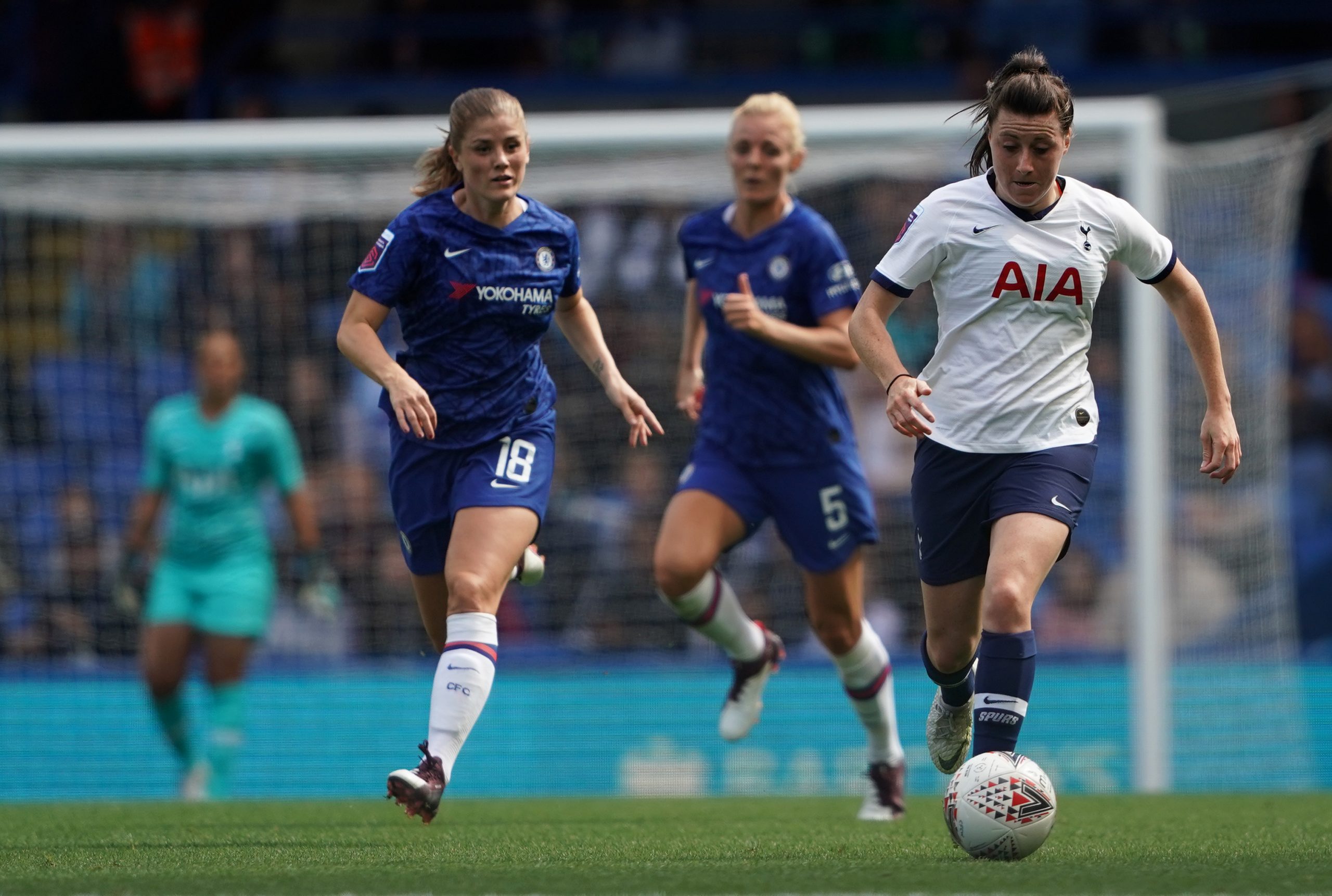Last season Bristol City were able to secure seven wins from 20 games despite scoring just 17 goals. Weekend opponents Brighton scored just 16 goals and won four games. The FA Women’s Super League media team must have been absolutely chuffed when they found out the powers that be had made this fixture one of the two opening games to be televised. Both side’s defensive activity maps last year were things to behold. There’s sitting deep, and there’s sitting deep, and there’s Bristol City and Brighton: 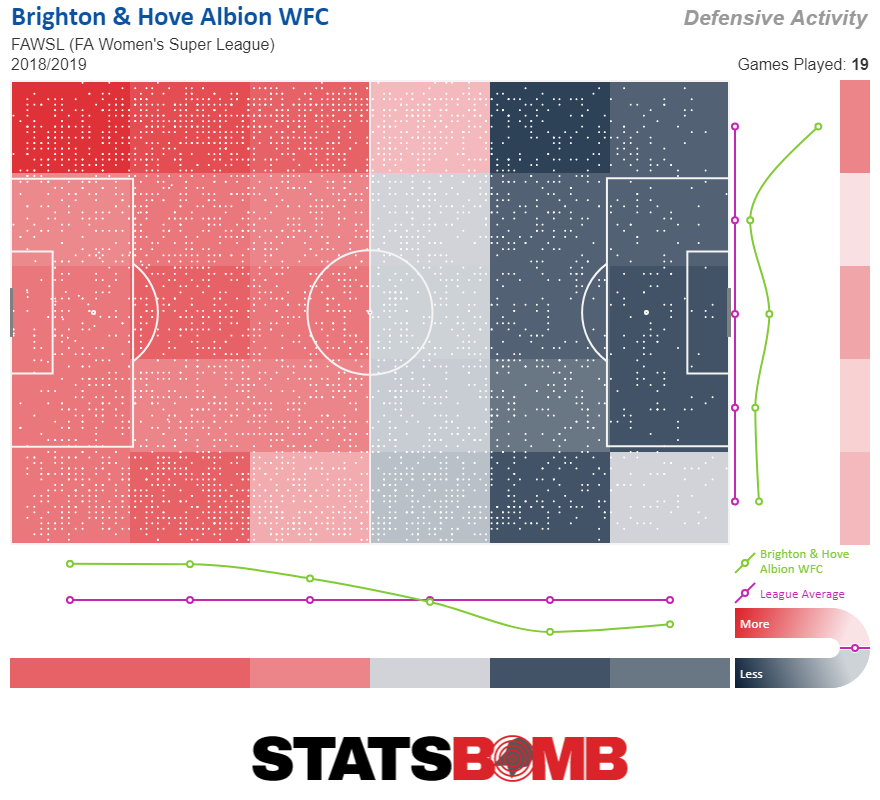
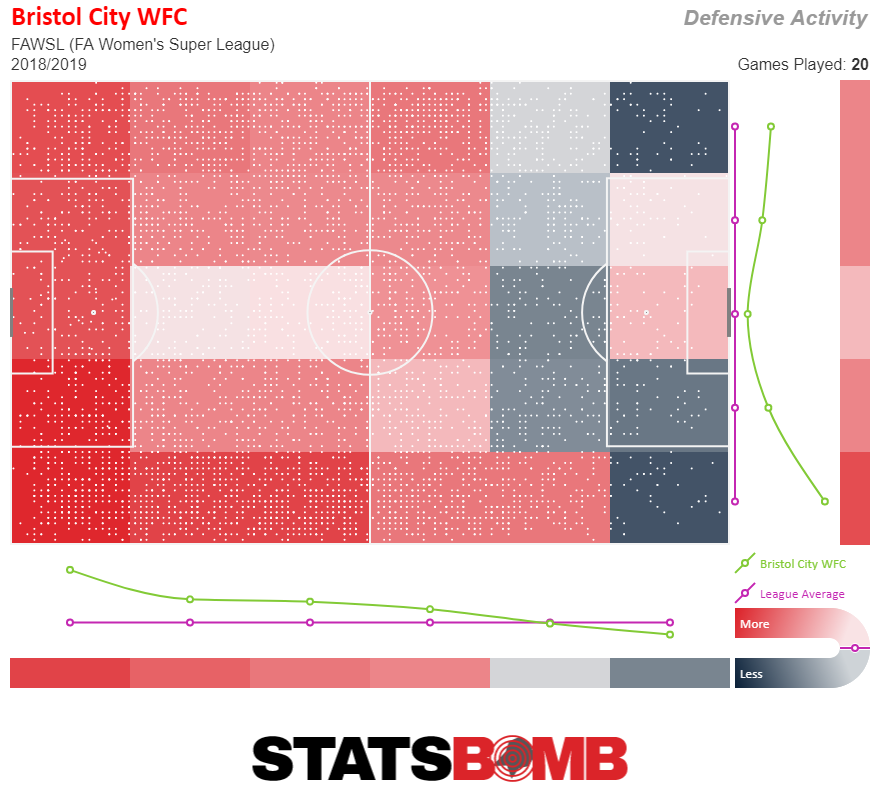 No surprise then that the game ended 0-0. However! Despite the similar outputs at season’s end in terms of goals, the underlying numbers suggested Brighton created nearly twice the amount of goal threat in terms of expected goals during the 2018-19 season. And that seemed to bear out in this game as Hope Powell’s Seagulls repeatedly pecked away at Tanya Oxtoby’s Vixens. By half time the shot count was 13-1 in Brighton’s favour (including a penalty brilliantly saved by Sophie Baggaley). At 75 minutes, that count had extended to 21-1. The introduction of Ebony Salmon and Olivia Chance stretched the game a little and there was a late flurry of activity but it still looked like this at the end:
No surprise then that the game ended 0-0. However! Despite the similar outputs at season’s end in terms of goals, the underlying numbers suggested Brighton created nearly twice the amount of goal threat in terms of expected goals during the 2018-19 season. And that seemed to bear out in this game as Hope Powell’s Seagulls repeatedly pecked away at Tanya Oxtoby’s Vixens. By half time the shot count was 13-1 in Brighton’s favour (including a penalty brilliantly saved by Sophie Baggaley). At 75 minutes, that count had extended to 21-1. The introduction of Ebony Salmon and Olivia Chance stretched the game a little and there was a late flurry of activity but it still looked like this at the end: 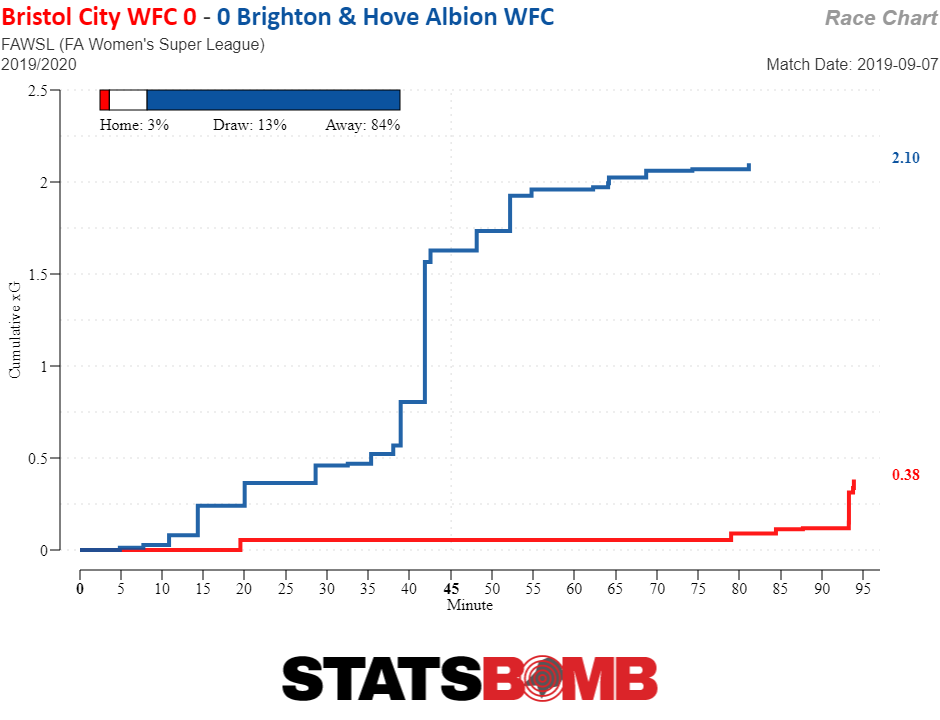 Ouch. The worry for Powell is that not taking chances, a habit that plagued Brighton last year, has already rolled over into the new season. Both main striking options, Kayleigh Green and Iniabasi Umotong, were culprits last season, ending up with goal tallies at nearly half of their xG totals. The positive is that the 2.1 xG posted here was as good as anything Brighton managed last year. The negative is that those high xG postings last year were against relegated Yeovil. And Bristol City may end up as this year’s Yeovil if they’re not careful. Chelsea took on Tottenham in front of a big crowd at Stamford Bridge and according to shots and xG it was another one-sided game. Newcomers Tottenham started conservatively with Ria Percival tasked to sit in front of the back four to protect and screen whilst watching the keeper and defenders play tippy-tap out from the back. It didn’t start well. In Spurs’ first build up, Percival (No.3) did her best to make a show of looking to receive the ball while never actually intending to. She was wrong-footed trying to move away from play just as the pass came, leaving Bethany England to pick the ball up and smash it into the top corner. It really was brutal punishment for Spurs starting in neutral:
Ouch. The worry for Powell is that not taking chances, a habit that plagued Brighton last year, has already rolled over into the new season. Both main striking options, Kayleigh Green and Iniabasi Umotong, were culprits last season, ending up with goal tallies at nearly half of their xG totals. The positive is that the 2.1 xG posted here was as good as anything Brighton managed last year. The negative is that those high xG postings last year were against relegated Yeovil. And Bristol City may end up as this year’s Yeovil if they’re not careful. Chelsea took on Tottenham in front of a big crowd at Stamford Bridge and according to shots and xG it was another one-sided game. Newcomers Tottenham started conservatively with Ria Percival tasked to sit in front of the back four to protect and screen whilst watching the keeper and defenders play tippy-tap out from the back. It didn’t start well. In Spurs’ first build up, Percival (No.3) did her best to make a show of looking to receive the ball while never actually intending to. She was wrong-footed trying to move away from play just as the pass came, leaving Bethany England to pick the ball up and smash it into the top corner. It really was brutal punishment for Spurs starting in neutral: 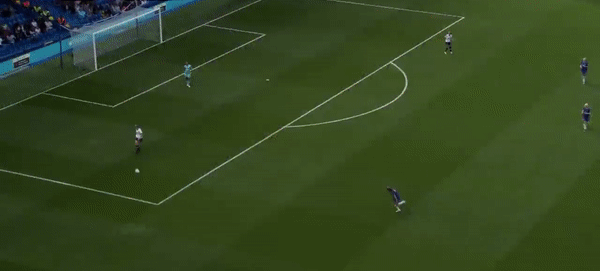 Percival continued to trundle about protecting the space in front of back four rather than aggressively seeking to destroy. She also continued to walk about and look entirely uninterested in receiving the ball during Tottenham’s build up play, appearing to tell team mates to calm down and ignore her as an option:
Percival continued to trundle about protecting the space in front of back four rather than aggressively seeking to destroy. She also continued to walk about and look entirely uninterested in receiving the ball during Tottenham’s build up play, appearing to tell team mates to calm down and ignore her as an option: 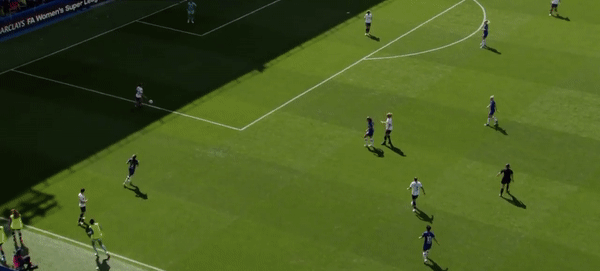
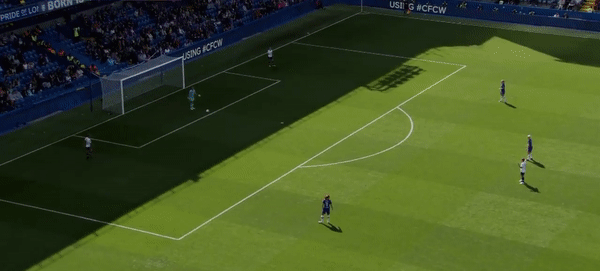 One nil down at half time, it looked like Spurs’ manager Karen Hills had to do something other than keep the ball away from Chelsea’s central midfield. And she did. On came Chloe Peplow for Coral Haines with Percival moved further forward. It started to look much better on the eye. Peplow (No.8) was immediately more aggressive and higher up the pitch in possession:
One nil down at half time, it looked like Spurs’ manager Karen Hills had to do something other than keep the ball away from Chelsea’s central midfield. And she did. On came Chloe Peplow for Coral Haines with Percival moved further forward. It started to look much better on the eye. Peplow (No.8) was immediately more aggressive and higher up the pitch in possession: 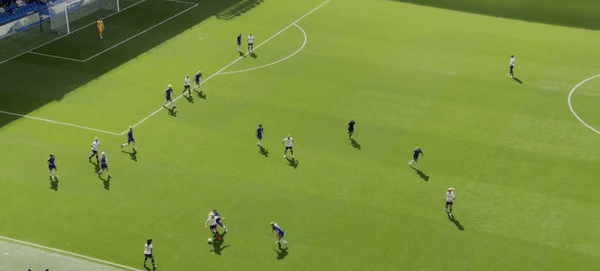 She was also more dynamic in build-up from the back, actually offering for the ball and then moving her marker around to create room to switch the ball around:
She was also more dynamic in build-up from the back, actually offering for the ball and then moving her marker around to create room to switch the ball around: 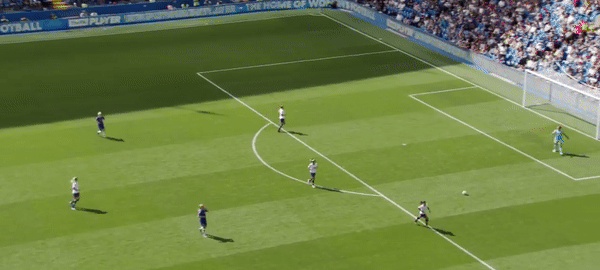
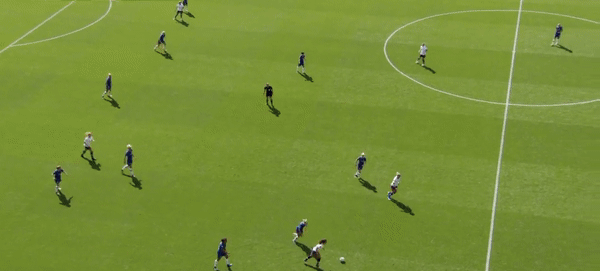 The effect on possession of the ball can be seen by comparing the pass networks before and after the break:
The effect on possession of the ball can be seen by comparing the pass networks before and after the break: 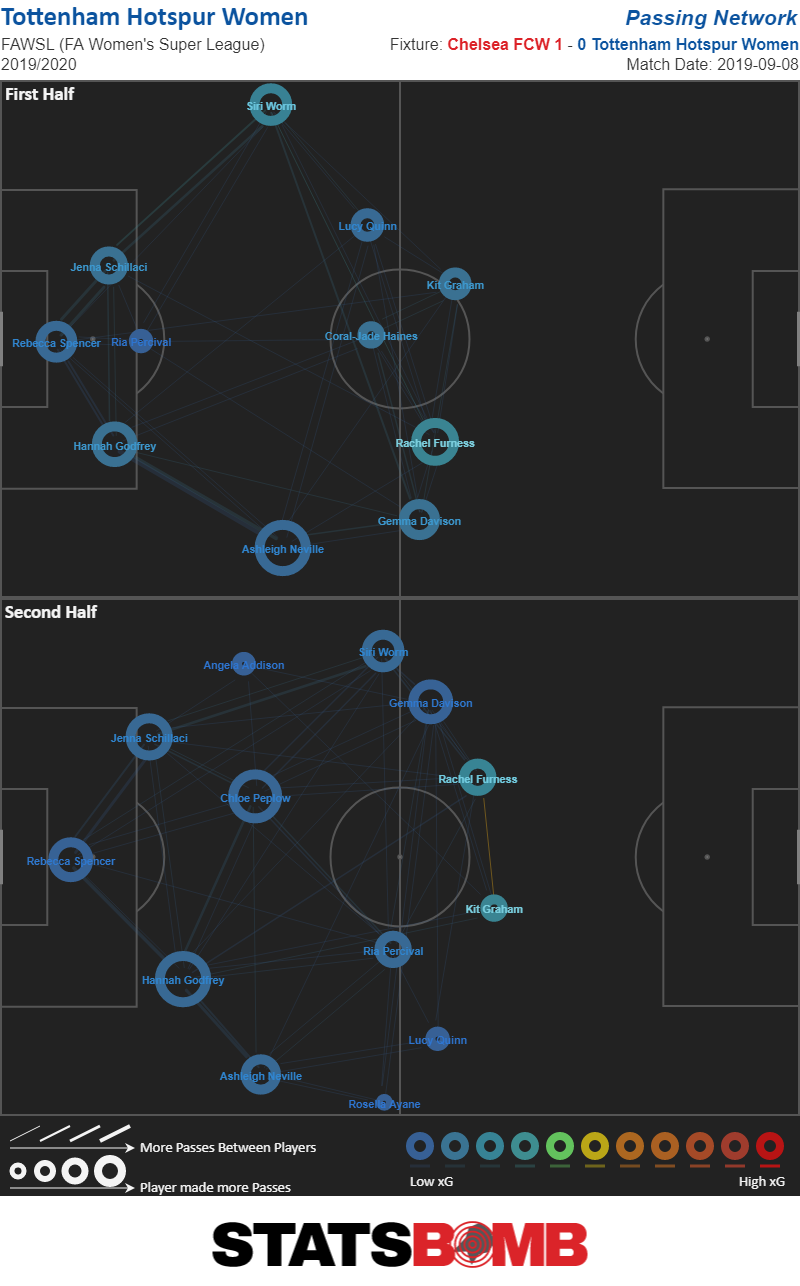 That said, it didn’t alter the flow of traffic in terms of attacking. Chelsea continued to dominate the shot count and the numbers were resoundingly in the Blues’ favour: I have to say, despite this awful looking chart, I enjoyed Tottenham’s performance.
That said, it didn’t alter the flow of traffic in terms of attacking. Chelsea continued to dominate the shot count and the numbers were resoundingly in the Blues’ favour: I have to say, despite this awful looking chart, I enjoyed Tottenham’s performance. 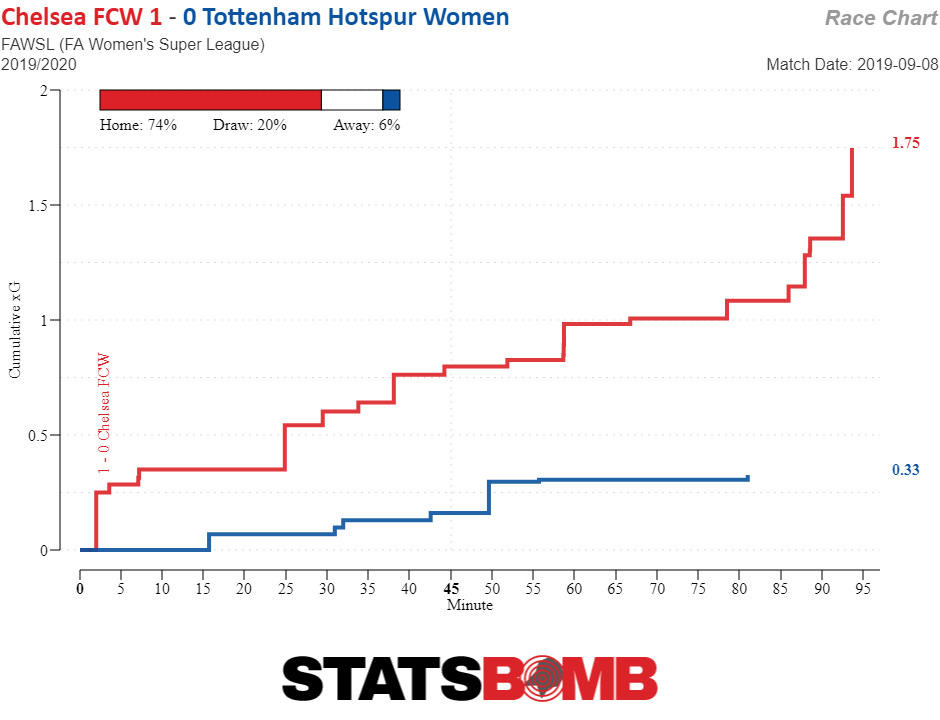 The first half plan of trying to stifle Chelsea and play down the sides wasn’t successful but at least Spurs’ were trying to stick to their principles of trying to build from the back. It gave the first half pass map the classic U-shaped look that connoisseurs of more direct football (people like me) are so fond of calling impolite words:
The first half plan of trying to stifle Chelsea and play down the sides wasn’t successful but at least Spurs’ were trying to stick to their principles of trying to build from the back. It gave the first half pass map the classic U-shaped look that connoisseurs of more direct football (people like me) are so fond of calling impolite words: 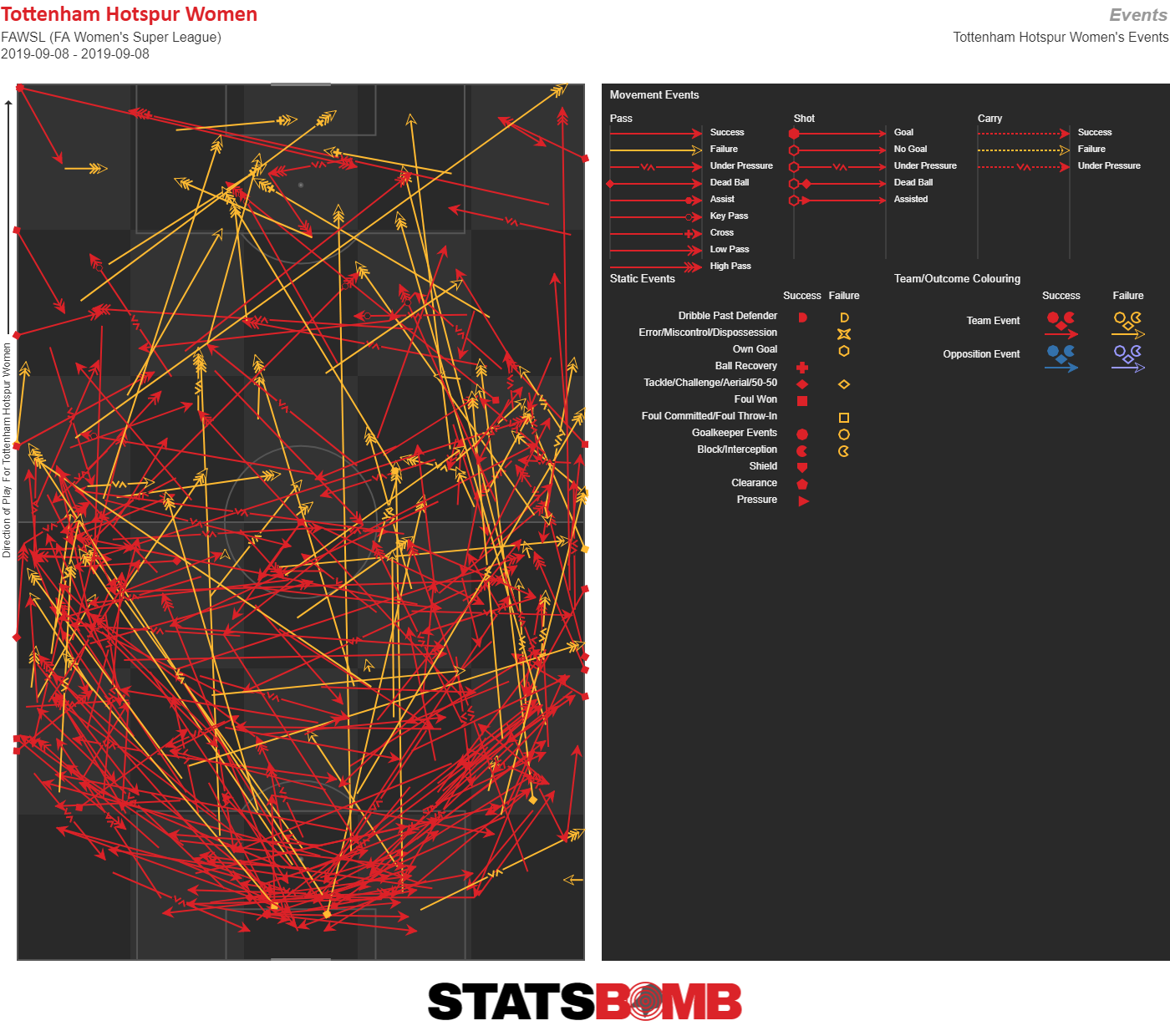 Still, despite Chelsea racking up the shots, Tottenham seemed fairly well drilled in defence and kept shape. Chelsea just looked more able physically. And had better players. Going forward, the odd attack on the break through Gemma Davison’s ball carrying and Siri Worm’s charges down the left felt more dangerous than the numbers suggested. Tottenham’s riskier second-half approach felt encouraging and should instil a bit of belief that against sides of lesser quality than Chelsea, this Spurs team should be able to mix it. Increasingly these days I’m in favour of teams using these ‘throwaway’ fixtures (against far superior opposition) to concentrate on their own game to help future performances - especially in a league as disparate and short in games as FAWSL. Arsenal, Manchester City and Chelsea are in a league of their own according to recent historic xG numbers. With a small number of fixtures to play against more evenly matched teams, is it worth wasting a few weeks a season practicing specific defensive game plans in the forlorn hope of snatching a point? It may be for Bristol City who’ll do it whoever they face, but Spurs and the rest? Not so much. I was therefore impressed with West Ham’s showing against Champions, Arsenal. Manager Matt Beard set the Irons up to have a decent go and so they did:
Still, despite Chelsea racking up the shots, Tottenham seemed fairly well drilled in defence and kept shape. Chelsea just looked more able physically. And had better players. Going forward, the odd attack on the break through Gemma Davison’s ball carrying and Siri Worm’s charges down the left felt more dangerous than the numbers suggested. Tottenham’s riskier second-half approach felt encouraging and should instil a bit of belief that against sides of lesser quality than Chelsea, this Spurs team should be able to mix it. Increasingly these days I’m in favour of teams using these ‘throwaway’ fixtures (against far superior opposition) to concentrate on their own game to help future performances - especially in a league as disparate and short in games as FAWSL. Arsenal, Manchester City and Chelsea are in a league of their own according to recent historic xG numbers. With a small number of fixtures to play against more evenly matched teams, is it worth wasting a few weeks a season practicing specific defensive game plans in the forlorn hope of snatching a point? It may be for Bristol City who’ll do it whoever they face, but Spurs and the rest? Not so much. I was therefore impressed with West Ham’s showing against Champions, Arsenal. Manager Matt Beard set the Irons up to have a decent go and so they did: 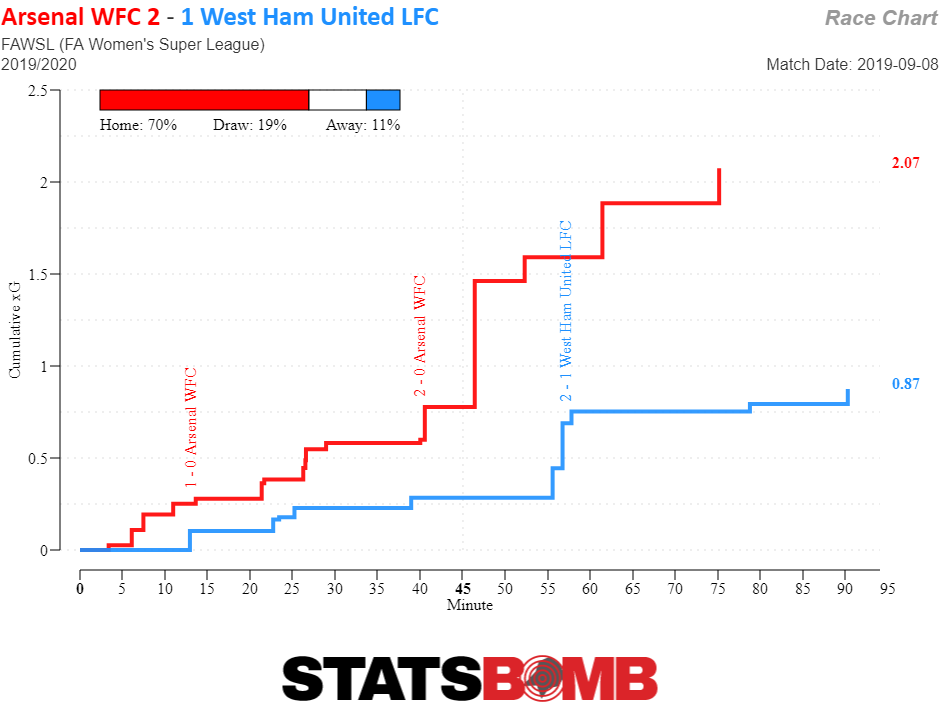 The front two, Martha Thomas and Kenza Dali, both brought in from French clubs look an intriguing pairing. Dali dropped deep to pull the strings while Thomas harried and harassed and scored an absolutely brilliant header, rising and nipping in front of her marker to steer the ball inside the post. This is the first time I’ve seen Thomas who played college soccer in the US before moving to Division 2 side Le Havre. She looked to have everything you’d want in a forward – pace, aerial ability, an eye for goal and a good old-fashioned enthusiasm for terrifying defenders. The Hammer’s certainly needed more creativity and firepower up front to improve last season’s middling numbers. As you can see from the trendline below, defence was perhaps the bigger problem for Beard early on in the season. Things got better as winter drew in:
The front two, Martha Thomas and Kenza Dali, both brought in from French clubs look an intriguing pairing. Dali dropped deep to pull the strings while Thomas harried and harassed and scored an absolutely brilliant header, rising and nipping in front of her marker to steer the ball inside the post. This is the first time I’ve seen Thomas who played college soccer in the US before moving to Division 2 side Le Havre. She looked to have everything you’d want in a forward – pace, aerial ability, an eye for goal and a good old-fashioned enthusiasm for terrifying defenders. The Hammer’s certainly needed more creativity and firepower up front to improve last season’s middling numbers. As you can see from the trendline below, defence was perhaps the bigger problem for Beard early on in the season. Things got better as winter drew in: 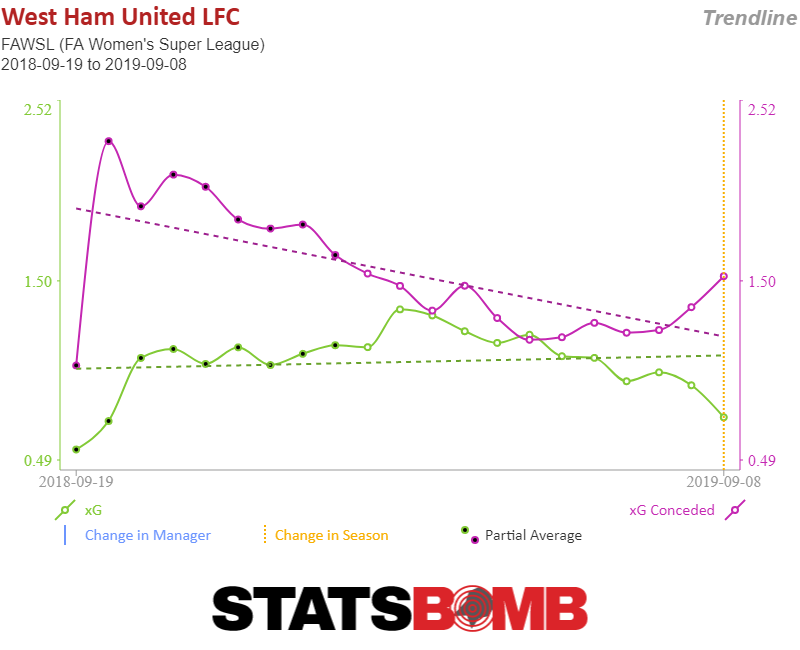 However, still clearly feeling the need for reinforcements, West Ham signed left-sided German defensive duo Katharina Baunach and Laura Vetterlein in the summer along with right-back Cecilie Kvamme. All got game time this weekend but couldn’t stem the Arsenal tide. What they all did do, however, was get heavily involved in build-up. Midfielder, Tessel Middag, finally got to play some football in this country following two consecutive ACL injuries. The Dutch international will feel she has some catching up to do. West Ham are going to be an interesting side to watch this year. Newly promoted Manchester United complete my hattrick of plucky losers on opening weekend. The difference here is they actually beat Manchester City on the xG count 0.78 to 0.40 even if they did get beat in reality. No team managed to restrict City that much in a game last season. So how did United do it? Like Spurs, United tried to play round the outside of the opponent. They also created a nice U-shape for the pass map but they did something different too. They continually sent the ball long into wide areas and the inside channels:
However, still clearly feeling the need for reinforcements, West Ham signed left-sided German defensive duo Katharina Baunach and Laura Vetterlein in the summer along with right-back Cecilie Kvamme. All got game time this weekend but couldn’t stem the Arsenal tide. What they all did do, however, was get heavily involved in build-up. Midfielder, Tessel Middag, finally got to play some football in this country following two consecutive ACL injuries. The Dutch international will feel she has some catching up to do. West Ham are going to be an interesting side to watch this year. Newly promoted Manchester United complete my hattrick of plucky losers on opening weekend. The difference here is they actually beat Manchester City on the xG count 0.78 to 0.40 even if they did get beat in reality. No team managed to restrict City that much in a game last season. So how did United do it? Like Spurs, United tried to play round the outside of the opponent. They also created a nice U-shape for the pass map but they did something different too. They continually sent the ball long into wide areas and the inside channels: 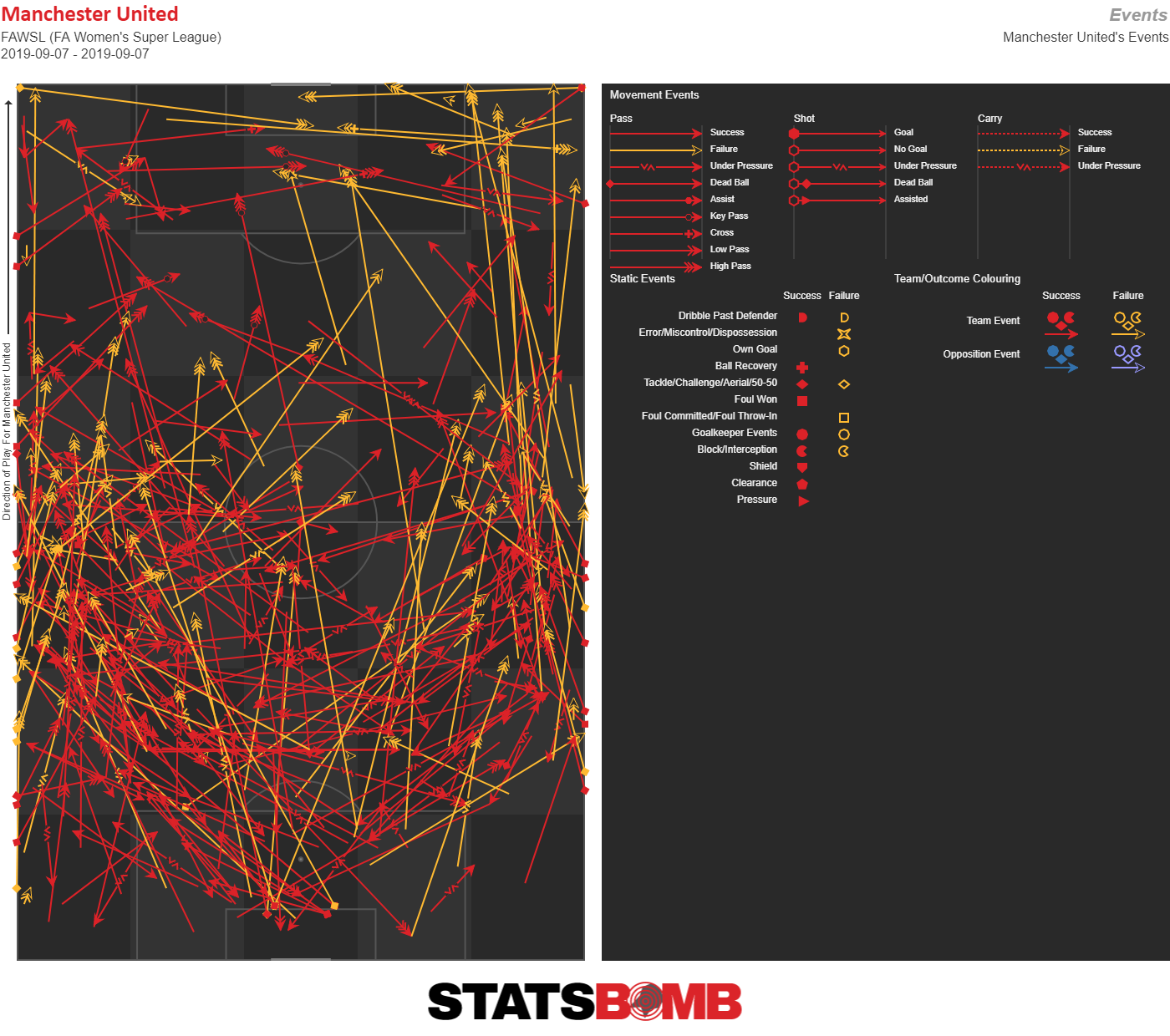 This enabled two things. Firstly, an ability to create chances by turning City towards their own goal:
This enabled two things. Firstly, an ability to create chances by turning City towards their own goal: 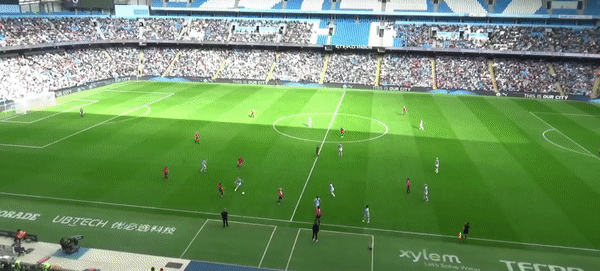
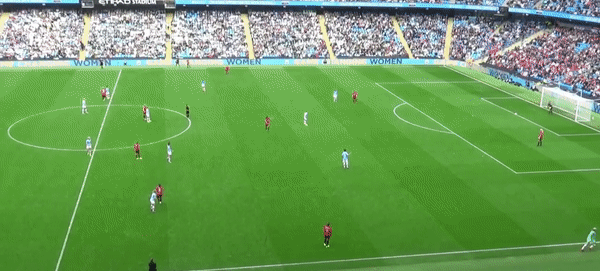 Look how many United players bomb on in support in those clips making it 4v4 and 3v3. Secondly, even when the ball was given away, the long ball and application of pressure meant City had to build from their own third rather than on half way. This happened again and again. It was really aggressive from United and kept City far away from the danger zones. There are plenty of routes to watching live FAWSL games for free this season. If you haven’t yet, then you should. It’s a product that’s going to get better and better and better. And Statsbomb have all the data, and it's all free if teams want it.
Look how many United players bomb on in support in those clips making it 4v4 and 3v3. Secondly, even when the ball was given away, the long ball and application of pressure meant City had to build from their own third rather than on half way. This happened again and again. It was really aggressive from United and kept City far away from the danger zones. There are plenty of routes to watching live FAWSL games for free this season. If you haven’t yet, then you should. It’s a product that’s going to get better and better and better. And Statsbomb have all the data, and it's all free if teams want it.
2019
The Super League's action filled (ish) opening weekend
By Will Humphrey
|
September 14, 2019
